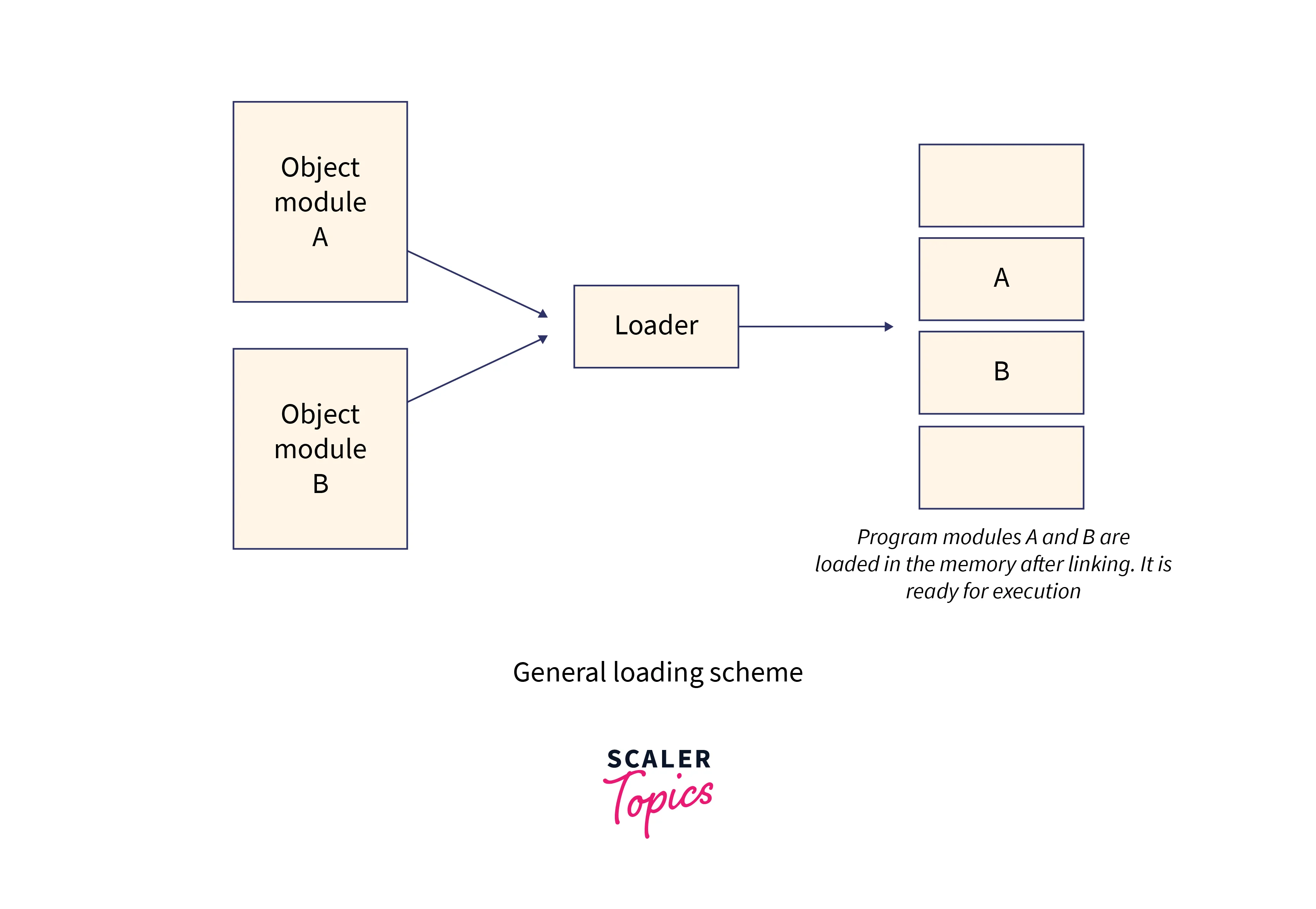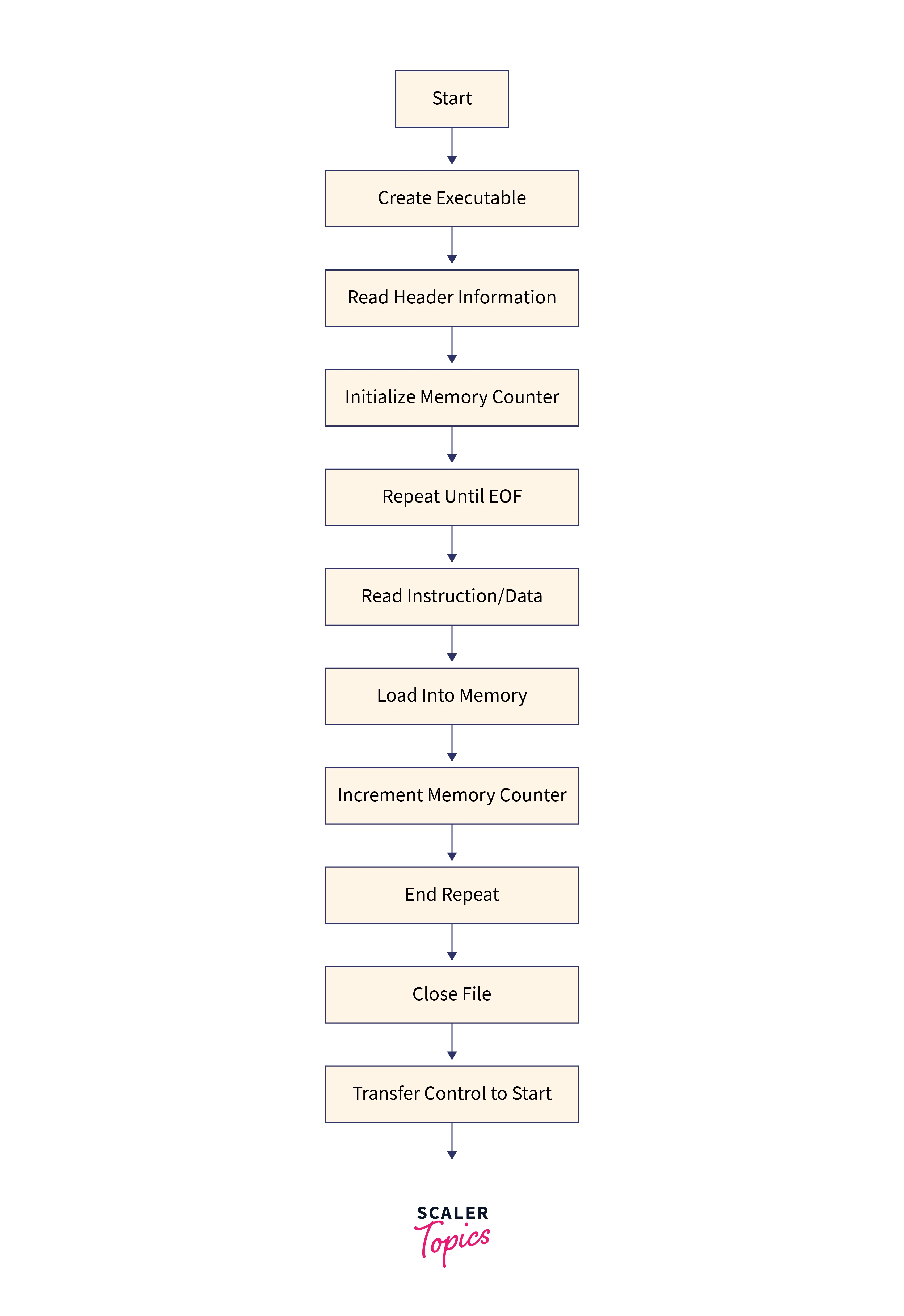What is Loader, How it is Different from Linker?
Overview
Loaders and linkers are pivotal components within operating systems. Loaders prepare executable files, allocating memory and resolving references, for CPU execution. Linkers combine separate object files into a single executable, resolving symbols across files. In tandem, these tools ensure smooth program execution by handling memory allocation and symbol resolution.
What is Loader?

A loader is a software component in an operating system that loads executable programs or software modules into memory for execution by the CPU. It performs tasks such as allocating memory space, relocating program code to the appropriate memory addresses, and resolving external references between different parts of the program. This process is essential for preparing a program to be executed effectively within the computer's memory space.
Functions of Loader
The loader is responsible for several crucial functions in the execution of programs:
- Memory Allocation:
The loader allocates memory space for the program in the computer's memory. It ensures that the program's instructions and data have the necessary memory addresses to operate properly. - Address Binding:
It performs the process of address binding, which involves associating symbolic addresses used in the program with actual memory addresses. This can include absolute, relative, or dynamic addressing, ensuring that the program can access its required resources correctly. - Relocation:
If the program is designed to be loaded at a different memory location than its original compilation address, the loader performs relocation. It adjusts the program's memory references to reflect the new starting address. - Linking and Symbol Resolution:
The loader resolves references to external symbols, such as functions or variables, by matching them with their actual locations in other modules or libraries. This allows different parts of the program to communicate and interact seamlessly. - Loading and Execution:
The loader physically loads the program's machine code and data into memory, making it ready for execution by the CPU. Once loaded, the loader transfers control to the program's starting point, initiating its execution. - Error Detection:
The loader checks for potential errors during the loading process, such as insufficient memory, incompatible machine code formats, or unresolved symbols. It informs the user or programmer about any issues that could prevent successful execution.
Overall, the loader plays a critical role in preparing executable programs for smooth and efficient execution on an operating system by managing memory allocation, address binding, symbol resolution, and error detection.
What is an Absolute Loader?
An absolute loader is a type of loader used in the context of early computer systems and programming languages. It is responsible for loading a program into memory without performing any additional address relocation or modification. In other words, an absolute loader assumes that the program has been compiled to run at a specific memory location and loads it into that predetermined memory address.
Key characteristics of an absolute loader include:
- No Address Relocation:
Unlike more advanced loaders, absolute loaders do not perform any address relocation or modification of the program's code or data. The program is loaded directly into the memory addresses for which it was compiled. - Fixed Memory Locations:
The program must be compiled to operate at specific memory locations. If the program needs to be loaded at a different memory address, it would require recompilation. - Simplicity:
Absolute loaders are relatively simple in design and implementation since they don't need to handle complex address calculations or symbol resolution. - Limited Flexibility:
Because the program's memory address is fixed, absolute loaders lack flexibility in terms of memory utilization. It can lead to issues if memory conflicts or fragmentation occur. - Historical Context:
Absolute loaders were more common in early computing environments where memory management and dynamic loading were less sophisticated.
As computing technology evolved, absolute loaders gave way to more versatile loaders that could handle dynamic memory allocation, address relocation, and symbol resolution. These advancements led to more efficient memory usage and greater flexibility in program execution.
Algorithm
The algorithm of an absolute loader is relatively straightforward due to its simplicity. It involves reading machine code instructions and data from a file and loading them into memory locations specified in the program. Here's a basic outline of the algorithm for an absolute loader:
-
Read Header Information:
- Open the executable file containing the program to be loaded.
- Read any necessary header information that might include memory addresses and program size.
-
Load Program into Memory:
- Read machine code instructions and data from the file one by one.
- Load each instruction or data element into its predetermined memory address.
-
Repeat Until End of File:
- Continue reading and loading instructions/data until the end of the file is reached.
-
Close File:
- Close the executable file as it's no longer needed for loading.
-
Execution:
- Transfer control to the starting address of the loaded program to begin its execution.
While this algorithm provides a basic framework for an absolute loader, it's important to note that real-world loaders, especially in modern operating systems, are much more complex due to the need for memory management, address relocation, symbol resolution, error handling, and support for various executable file formats. However, the core idea of loading a program into specific memory addresses without address relocation remains a characteristic of the absolute loader concept.
Flowchart
Now since we have learned the algorithm of absolute loader, let us summarize through a flowchart.

Difference between Linker and Loader
Let us now look into the following comparison table highlighting the main differences between loaders and linkers:
| Aspect | Loader | Linker |
|---|---|---|
| Function | Loads executable files into memory | Combines object files into an executable |
| Purpose | Prepare a program for execution | Create a unified executable program |
| Address Binding | Performs address binding for relocation | Resolves symbols across multiple files |
| Memory Allocation | Allocates memory space for program | Doesn't allocate memory |
| Symbol Resolution | No involvement in symbol resolution | Resolves external references |
| Relocation | Handles relocation of program code | No relocation; focuses on linking |
| Error Handling | Detects loading errors | Detects linking errors |
| Output | Loads program for execution | Generates an executable program file |
| Dependency Management | No involvement in linking dependencies | Manages dependencies between modules |
| Stage in Compilation | After compilation, before execution | After compilation, before execution |
| Complexity | Less complex due to limited tasks | More complex due to symbol resolution |
| Historical Relevance | Relevant in early computing systems | Relevant in modern computing as well |
Tips: While this table provides a concise overview of the differences between loaders and linkers, each component has its own nuances and variations based on the specific operating system and development environment being used.
FAQs
Q: What is the role of a loader in an operating system?
A: A loader is responsible for loading executable programs into memory for CPU execution.
Q: How does an absolute loader differ from other types of loaders?
A: An absolute loader loads programs at fixed memory addresses without performing address relocation.
Q: What are the main functions of a linker?
A: Linkers combine object files into an executable and resolve symbols across different program modules.
Q: How does a linker contribute to program execution?
A: Linkers create a unified executable program by resolving external references and linking modules together.
Q: What are some key tasks performed by a loader during the loading process?
A: Loaders allocate memory, perform address binding, and relocate program code to prepare it for execution.
Conclusion
- Loaders and linkers are essential components of operating systems that facilitate the execution of programs by preparing them for CPU operation and resolving dependencies.
- Loaders allocate memory, bind addresses, relocate code, resolve symbols, and handle error detection, ensuring a program's successful execution in memory.
- Linkers, on the other hand, focus on combining object files, resolving symbols, and managing dependencies between different program modules, resulting in a coherent executable.
- As computing technology evolved, loaders and linkers became more sophisticated, accommodating dynamic memory allocation, addressing flexibility, and complex symbol resolution to enable efficient and modular program execution.
